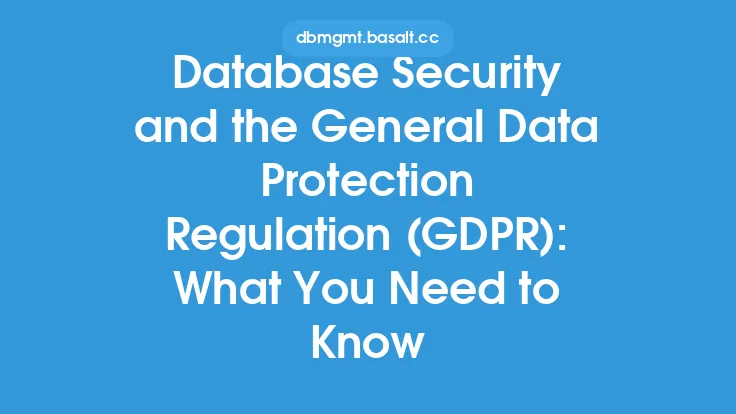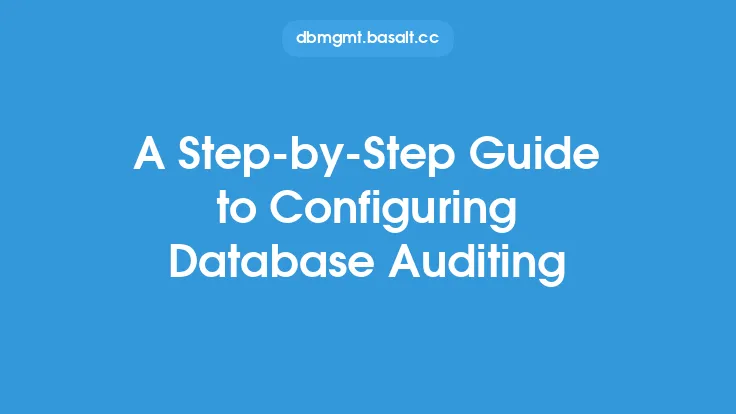Database auditing is a critical component of database security, and one of the key elements of database auditing is the audit trail. An audit trail is a record of all changes, actions, and events that occur within a database, providing a clear picture of who did what, when, and why. In this article, we will delve into the world of database audit trails, exploring what they are, why they are important, and what you need to know to implement and manage them effectively.
Introduction to Audit Trails
An audit trail is a chronological record of all events that occur within a database, including changes to data, schema, and permissions. It provides a detailed account of all activities, including who made the changes, when they were made, and what changes were made. Audit trails are essential for maintaining the integrity and security of a database, as they provide a clear audit log of all events, allowing administrators to track and monitor database activity.
Benefits of Audit Trails
Audit trails offer several benefits, including improved security, compliance, and troubleshooting. By maintaining a detailed record of all database events, audit trails help to detect and prevent unauthorized access, data breaches, and other security threats. They also provide a clear audit log of all changes, making it easier to comply with regulatory requirements and industry standards. Additionally, audit trails can help to troubleshoot issues and resolve problems more quickly, as they provide a clear picture of what happened and when.
Types of Audit Trails
There are several types of audit trails, including system-level audit trails, application-level audit trails, and database-level audit trails. System-level audit trails capture events at the operating system level, such as login attempts and file access. Application-level audit trails capture events at the application level, such as user activity and data changes. Database-level audit trails capture events at the database level, such as data changes, schema changes, and permission changes.
Components of an Audit Trail
An audit trail typically consists of several components, including a timestamp, user ID, event type, and event details. The timestamp records the date and time of the event, while the user ID identifies the user who performed the action. The event type describes the type of event that occurred, such as a data change or a login attempt. The event details provide additional information about the event, such as the data that was changed or the login credentials that were used.
Best Practices for Implementing Audit Trails
Implementing audit trails requires careful planning and consideration. Best practices include configuring audit trails to capture all relevant events, storing audit trails in a secure location, and regularly reviewing and analyzing audit trails. It is also important to ensure that audit trails are tamper-proof and cannot be altered or deleted. Additionally, audit trails should be configured to capture events in real-time, allowing for prompt detection and response to security threats.
Challenges and Limitations of Audit Trails
While audit trails are a powerful tool for maintaining database security, they also present several challenges and limitations. One of the main challenges is the volume of data that is generated by audit trails, which can be overwhelming and difficult to analyze. Additionally, audit trails can impact database performance, particularly if they are not configured correctly. Furthermore, audit trails may not capture all events, particularly if they are not configured to capture certain types of events.
Tools and Technologies for Managing Audit Trails
There are several tools and technologies available for managing audit trails, including database management systems, security information and event management (SIEM) systems, and audit trail analysis software. Database management systems, such as Oracle and SQL Server, provide built-in audit trail capabilities, while SIEM systems, such as Splunk and LogRhythm, provide advanced analytics and reporting capabilities. Audit trail analysis software, such as Audit Vault and DbProtect, provide specialized tools for analyzing and reporting on audit trail data.
Conclusion
In conclusion, database audit trails are a critical component of database security, providing a detailed record of all events that occur within a database. By understanding the benefits, types, and components of audit trails, as well as best practices for implementing and managing them, organizations can improve their database security and compliance posture. While audit trails present several challenges and limitations, there are several tools and technologies available for managing and analyzing audit trail data. By leveraging these tools and technologies, organizations can unlock the full potential of audit trails and maintain the integrity and security of their databases.





